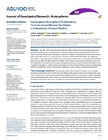Extratropical Atmospheric Predictability From the Quasi-Biennial Oscillation in Subseasonal Forecast Models
Abstract
The effect of the Quasi‐Biennial Oscillation (QBO) on the Northern Hemisphere wintertime stratospheric polar vortex is evaluated in five operational subseasonal forecasting models. Of these five models, the three with the best stratospheric resolution all indicate a weakened vortex during the easterly phase of the QBO relative to its westerly phase, consistent with the Holton‐Tan effect. The magnitude of this effect is well captured for initializations in late October and November in the model with the largest ensemble size. While the QBO appears to modulate the extratropical tropospheric circulation in some of the models as well, the importance of a polar stratospheric pathway, through the Holton‐Tan effect, for the tropospheric anomalies is unclear. Overall, knowledge of the QBO can contribute to enhanced predictability, at least in a probabilistic sense, of the Northern Hemisphere winter climate on subseasonal timescales. Show more
Permanent link
https://doi.org/10.3929/ethz-b-000286402Publication status
publishedExternal links
Journal / series
Journal of Geophysical Research: AtmospheresVolume
Pages / Article No.
Publisher
WileySubject
Quasi‐Biennial Oscillation; month‐ahead prediction; polar vortex; annular modesOrganisational unit
02717 - Institut für Atmosphäre und Klima / Inst. Atmospheric and Climate Science09612 - Domeisen, Daniela / Domeisen, Daniela
Funding
170523 - Improving the Prediction of Sub-seasonal to Seasonal Weather and Climate – From Theory to Application (SNF)
More
Show all metadata





